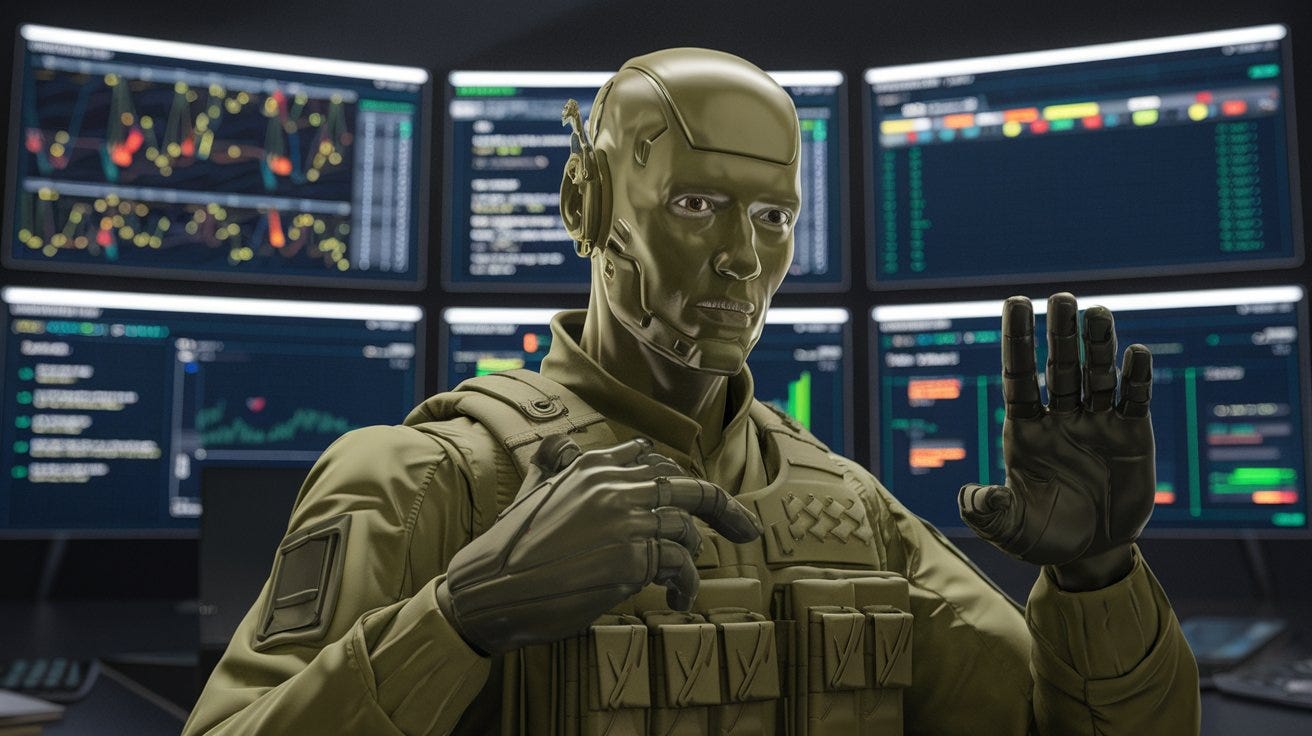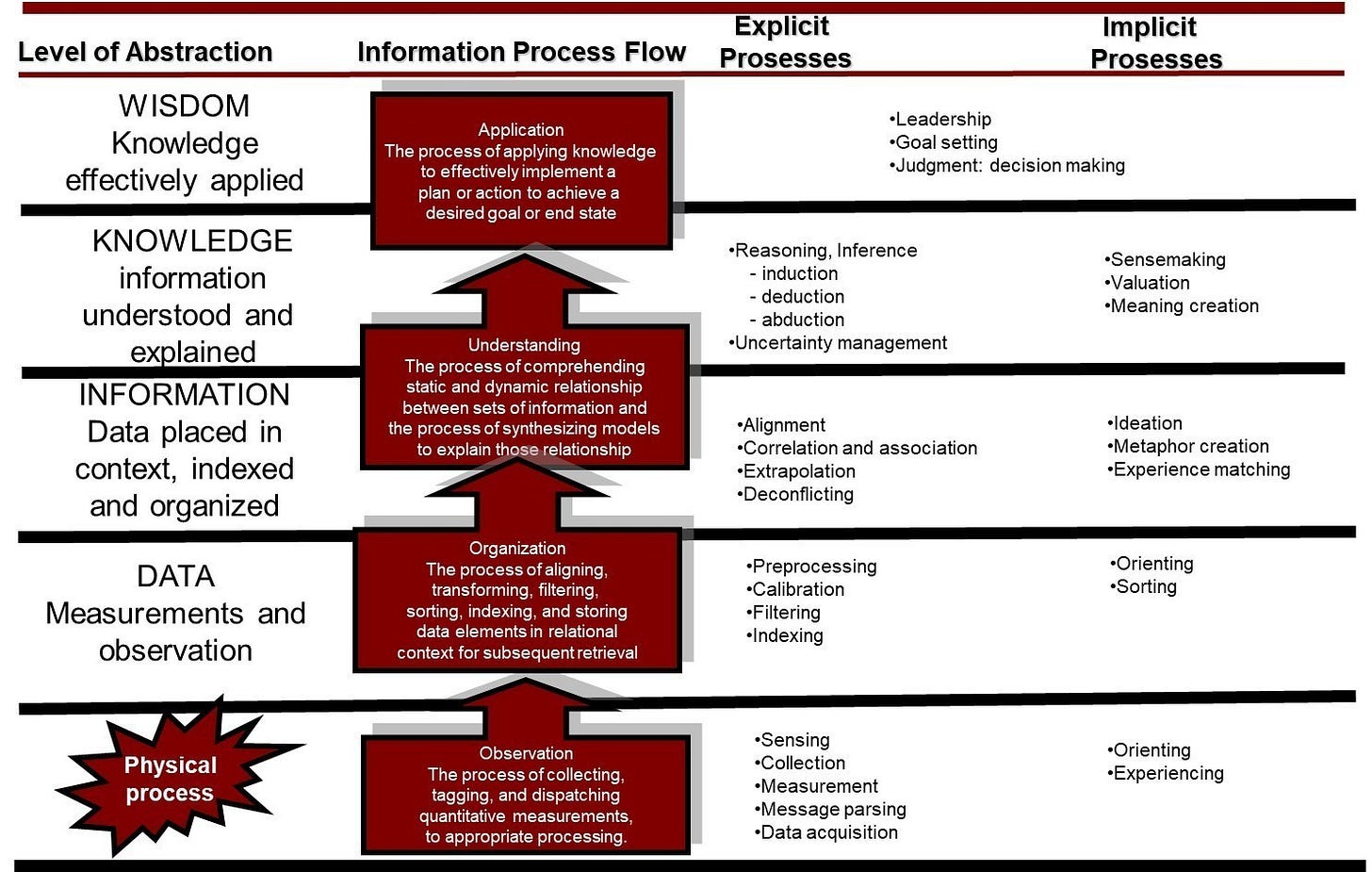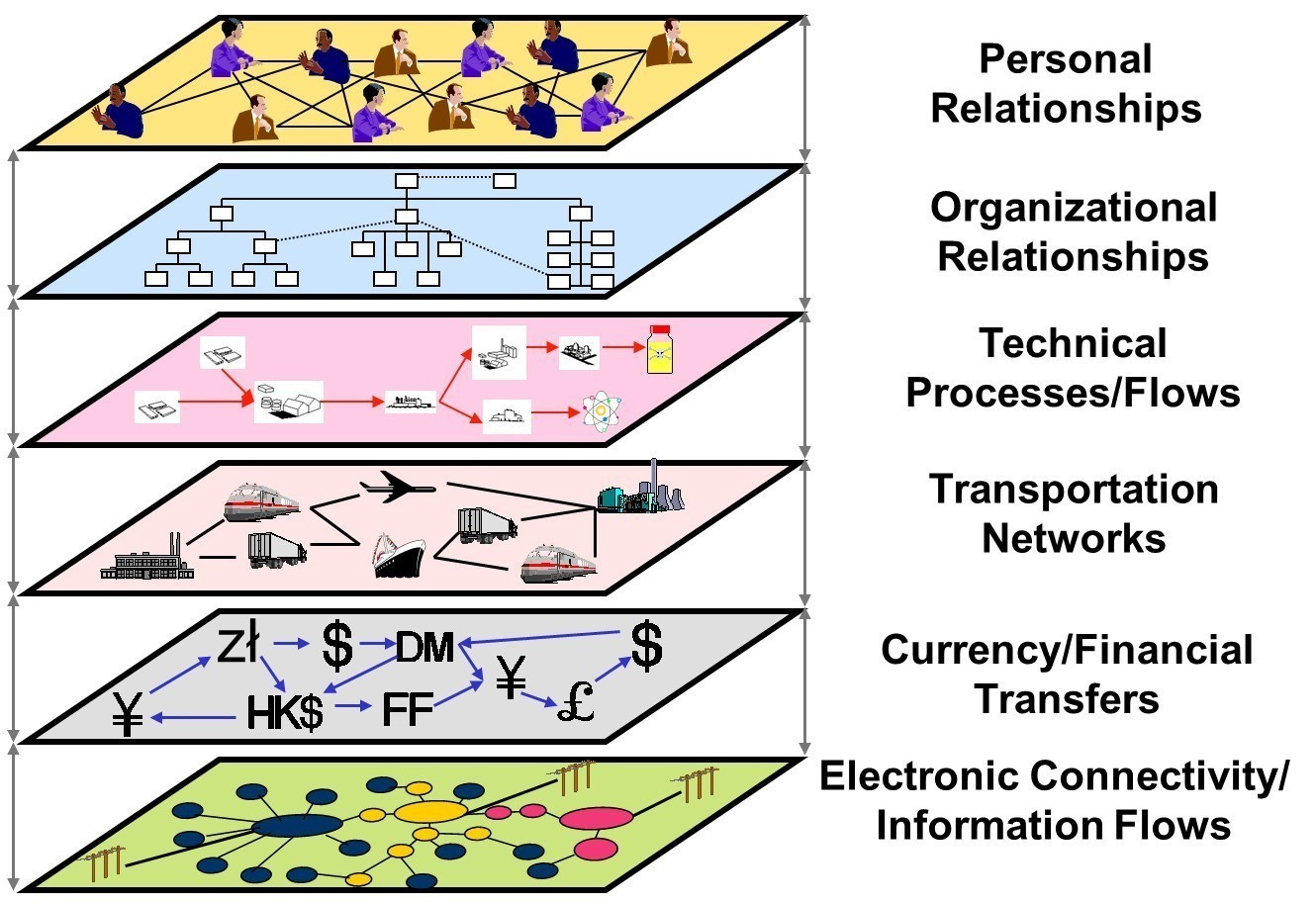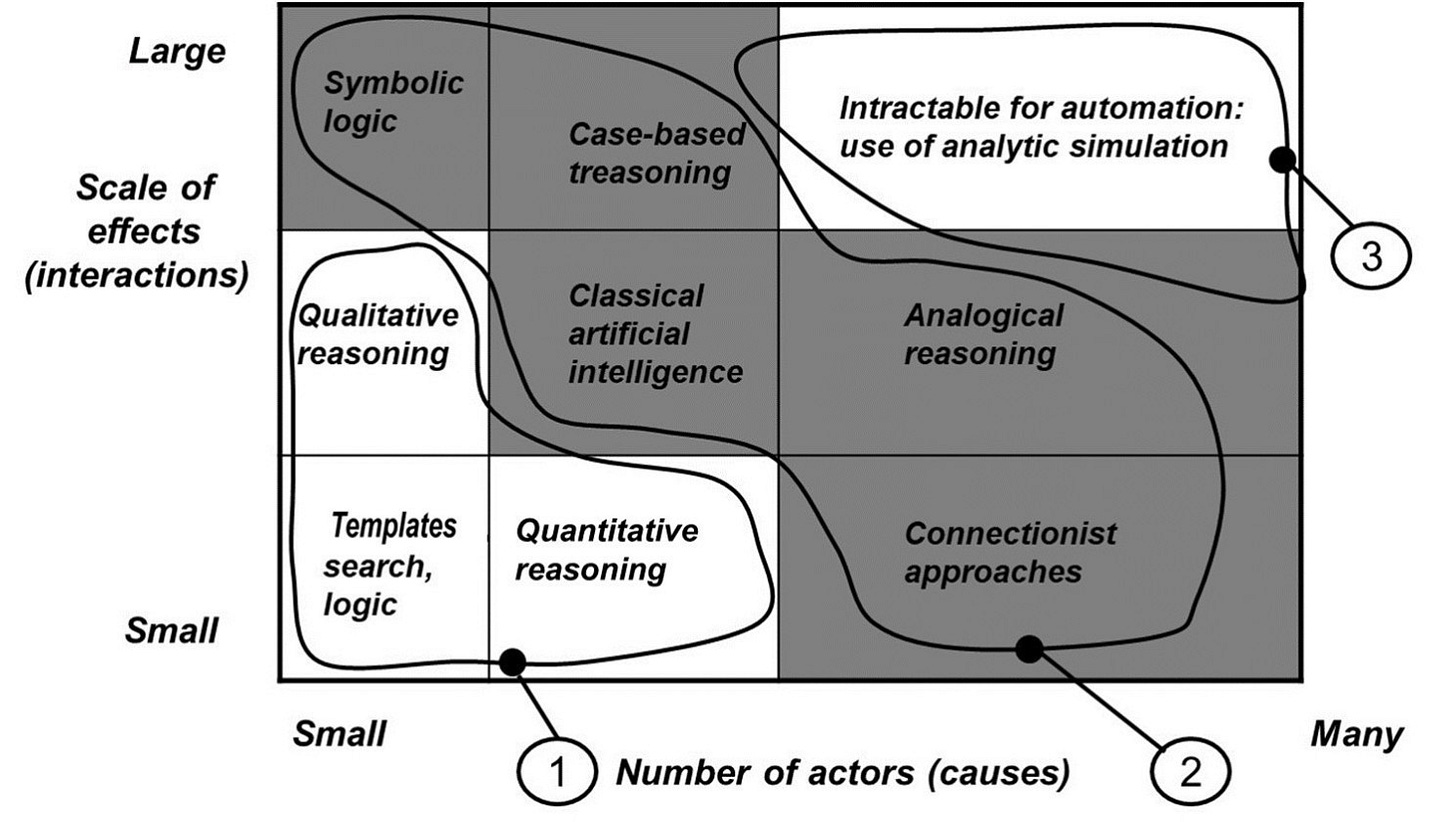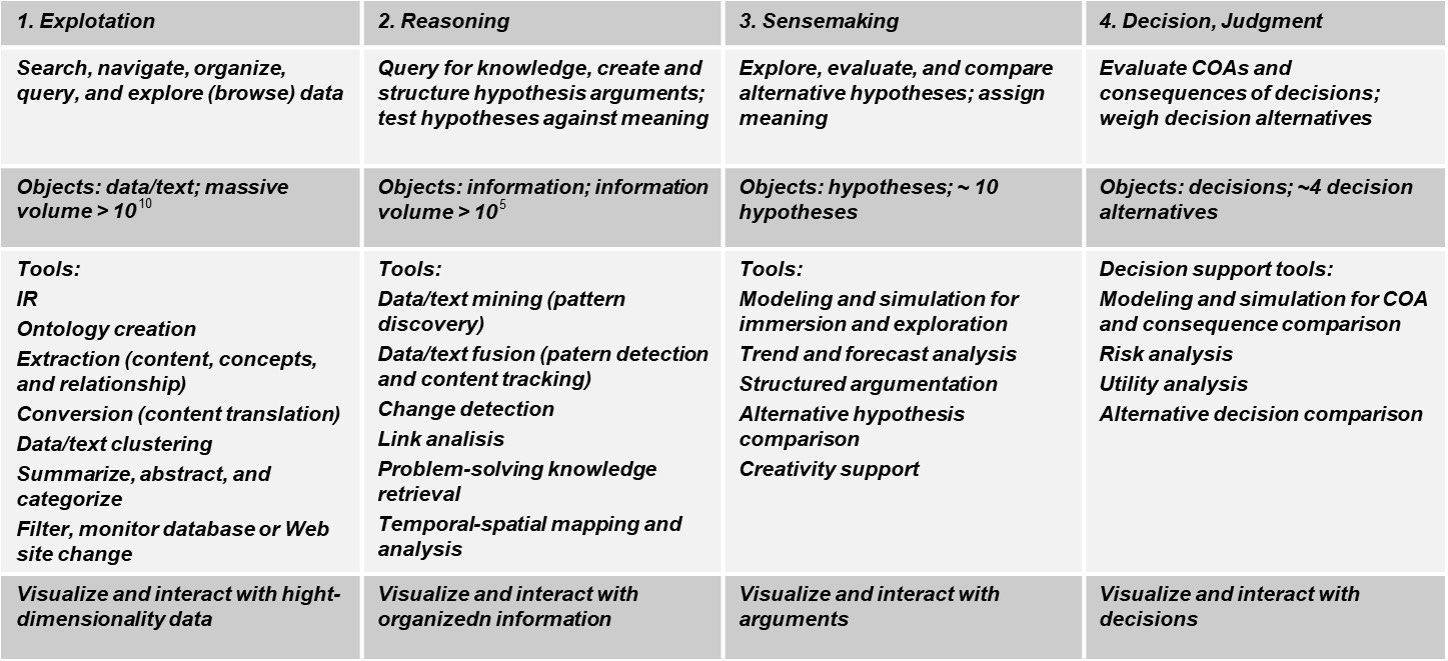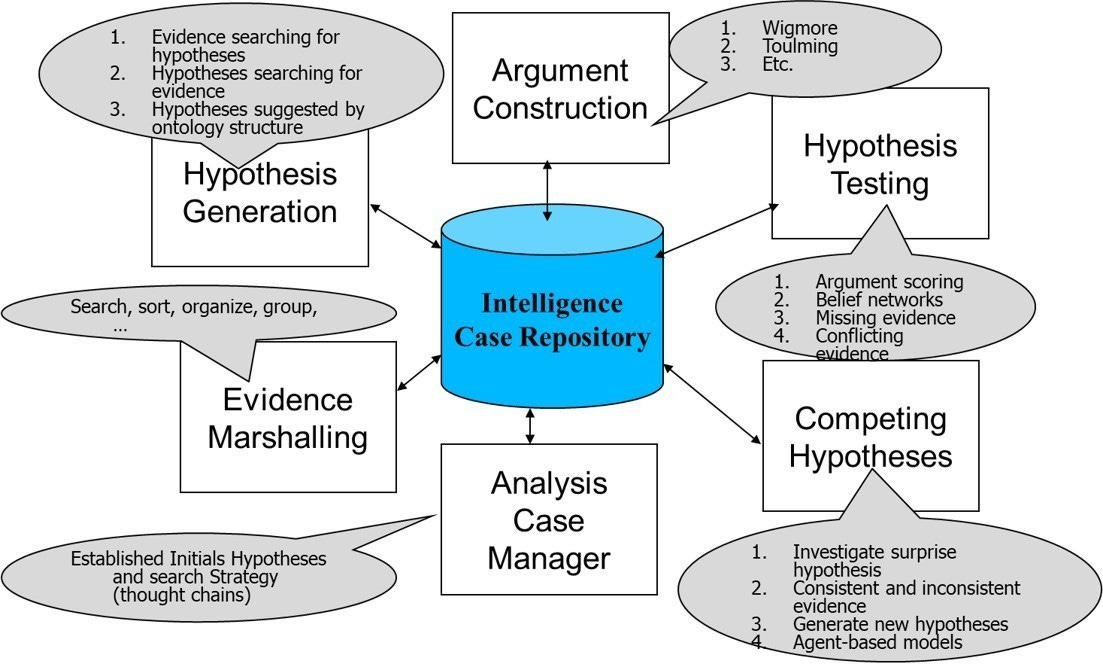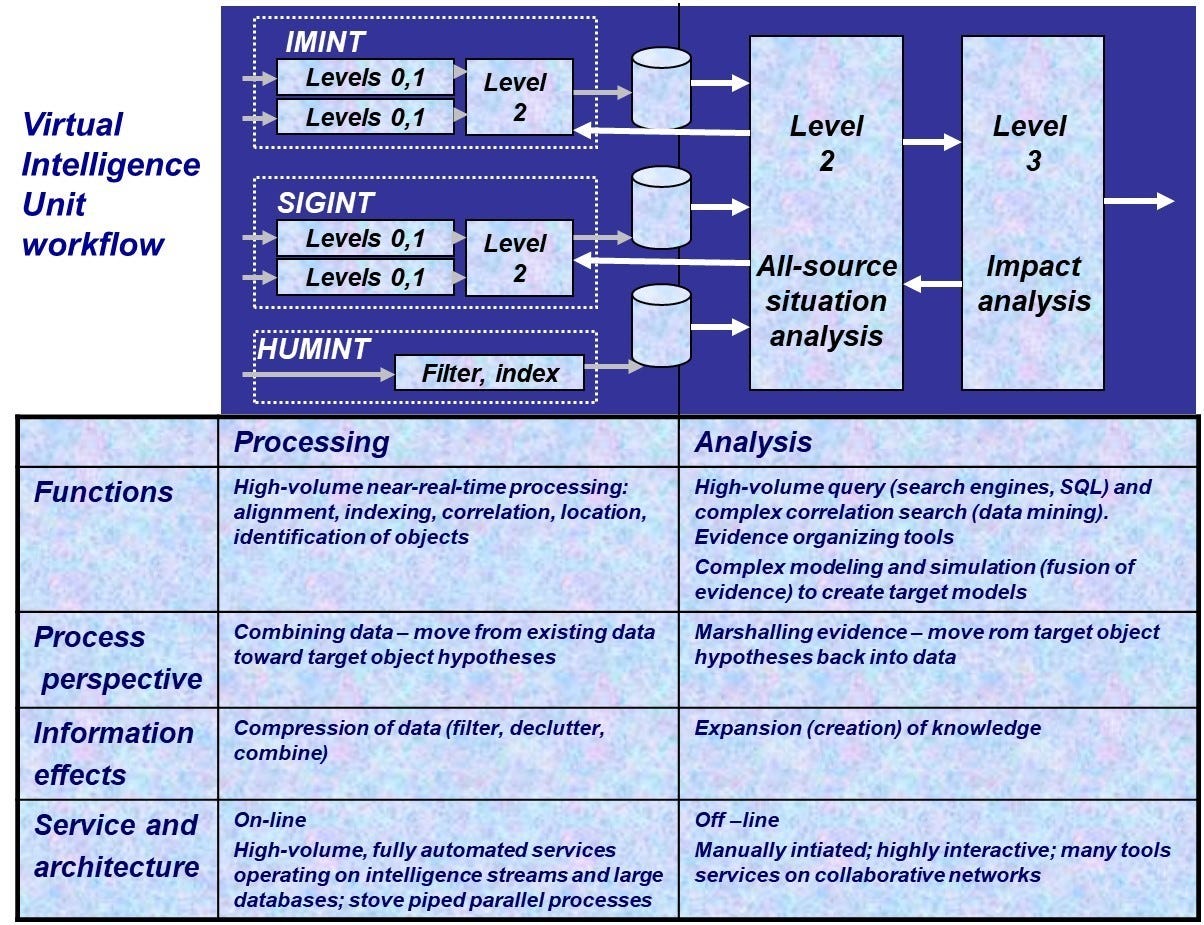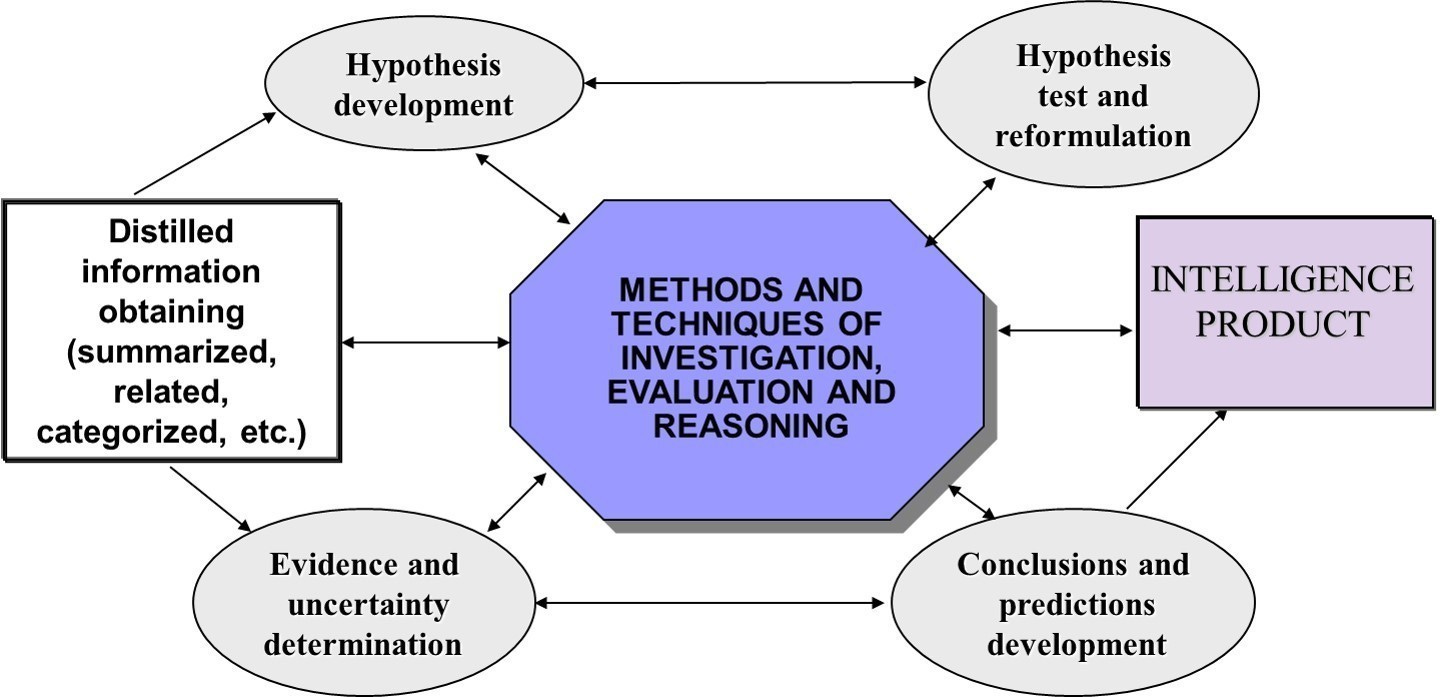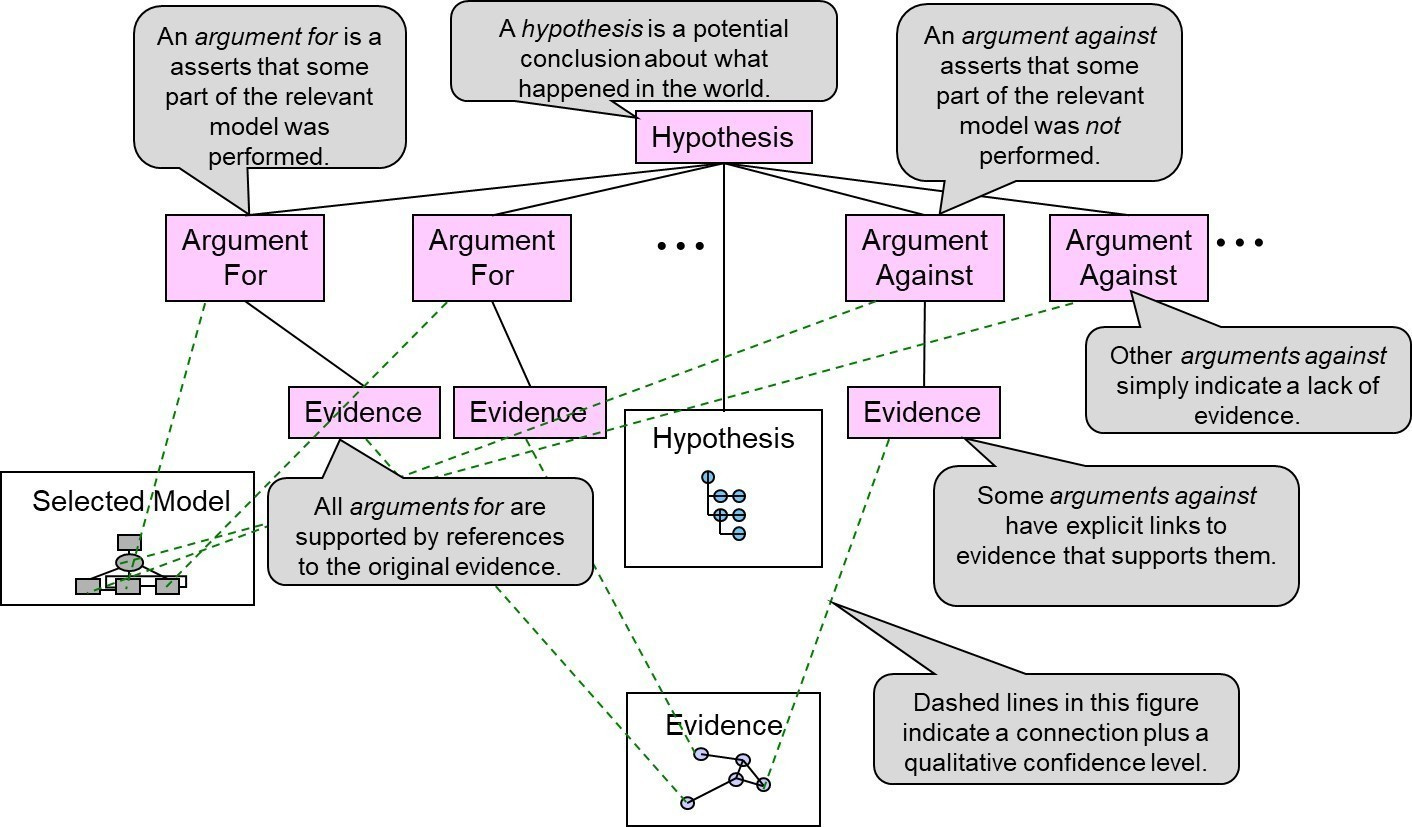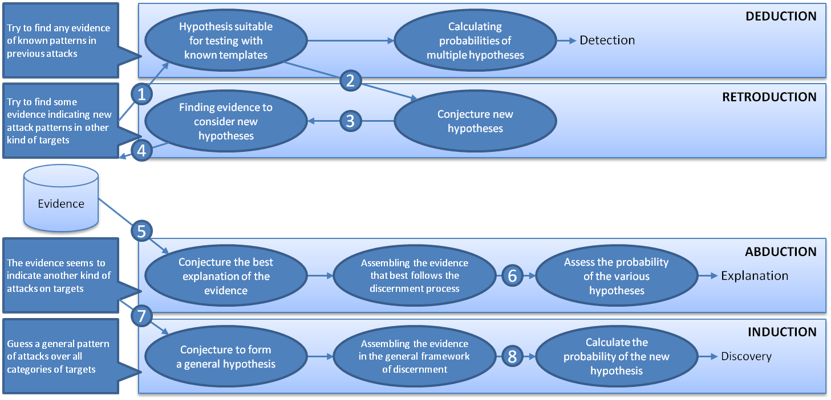Complex reasoning for multi-domain military intelligence analysis
Reading the mind of opponents 24×7×365 – Tireless Analyst Project (Virtual Analyst)
When one attempts to solve problems arising from outdated doctrines of thought, it becomes necessary to investigate the "supralogic" principles underlying our organization of thought—that is, the paradigms and hidden principles that govern our perception of the world, often without our awareness.
The intelligence failures in national security, stemming from the asymmetric, combinatory, contagious, and transversal nature of new threats (primarily terrorist, cyber, and hybrid warfare) that loom over nation-states, their citizens, and institutions, underscore the need to research and develop new paradigms that better address the challenges of the present and future.
"Solid intelligence on terrorism is not easy to develop… I would like to salute the unsung heroes of the struggle against terrorism. These heroes are the intelligence analysts. Often they have little to go on: a photograph, a fragment of an overheard conversation, the text of a communiqué, the summary of a meeting, a used airline ticket. Sometimes, it is like piecing together a gigantic jigsaw puzzle, but it is a puzzle that can save lives."
George Shultz
Former Secretary of State
This highlights the critical importance of intelligence analysts in addressing contemporary threats such as terrorism, physical war, organized cybercrime, cyberwarfare, and hybrid warfare.
“The rules of the game: learn everything, read everything, inquire into everything… When two texts, or two assertions, or perhaps two ideas, are in contradiction, be ready to reconcile them rather than cancel one by the other; regard them as two different facets, or two successive stages, of the same reality, a reality convincingly human just because it is complex.”
Marguerite Yourcenar, Memoirs of Hadrian
This quote illustrates the Stoic philosophical perspective on the inherent complexity involved in analyzing and understanding the real world.
From simplifying intelligence to complex reasoning: Embracing the Unitas-Multiplex perspective
In this context, I direct one of my work areas toward the "UNITAS-MULTIPLEX" approach—or Complex Reasoning—as opposed to the "paradigm of simplification" inherent in current intelligence production methods (characterized by disjunction, hierarchy, and abstraction).
Such "blind intelligence," based on oversimplification, dismantles wholes and totalities, isolates objects from their environments, and fails to appreciate the inseparable bond between the observer and the observed. Unfortunately, this unidimensional and truncated vision exacts a heavy toll on human outcomes.
Figure: A general view of the cognitive reasoning processes in the understanding of the real world
Political, military, and business organizations must adopt a complex reasoning paradigm because a true vision of reality emerges from engaging with uncertainty, randomness, instantaneous events, and the multiplicity of interactions and feedback loops. As Bachelard observed, "the simple does not exist; there is only the simplified."
Figure: Multidimensional patterns in intelligence analysis
AI reasoning systems applied to intelligence analysis (A cognitive approach).
In the early, transformative days of artificial intelligence, John McCarthy argued that training a system to learn is inseparable from the challenge of representing the involved knowledge—and from transforming that representation in the event of formal errors—so that it becomes increasingly suitable for the task at hand.
Figure: AI Reasoning Approaches in Intelligence Analysis Scenarios
This approach posits that generating new thoughts from existing ones is integral to the intelligent development of mental representations. It encompasses the essential abilities of intelligence: creativity, understood as the capacity to generate novel representations of the world; learning, as the process of refining cognitive abilities under external influences; and problem solving, as the set of skills applied to overcome states or situations that hinder the formulation of strategies to achieve goals.
Figure: Cognitive AI reasoning processes in intelligence analysis
When we define the intelligence analysis process as a mental activity systematically aimed at uncovering the meaning and underlying causes of events within a real-world domain—and adapt this definition to the "UNITAS-MULTIPLEX" approach—we can delineate the application of complex reasoning in intelligence analysis along the following methodological, technological, and doctrinal dimensions:
A new methodological framework: Establishing a framework that integrates the essential premises of complex reasoning through automatic reasoning sequences.
A new generation of intelligence products: Developing intelligence outputs with novel objectives, formats, and content.
Socio-technical intelligence analysis systems: Creating systems aligned with these new methodological approaches.
Currently, intelligence systems are commonly perceived as computer systems that address specific processes within the traditional intelligence cycle. These systems primarily offer the following functionalities:
Capturing and systematically integrating information from multiple sources.
Extracting and organizing relevant entities and elements, either individually or as the basis for further analysis.
Organizing information to elucidate the relationships within it as a cohesive whole.
Operating independently of language and the structural form of the original content.
Storing, searching, and representing detected relationships in various formats—whether identified automatically or by an analyst.
Monitoring relevant information and issuing alerts upon the arrival or manual entry of new data.
Automating report generation and ensuring timely dissemination for decision-making purposes.
In my experience, these technological functionalities do not achieve their maximum potential because projects are often not accompanied by an organizational transformation in the doctrine of intelligence analysis or in the application of these new technologies to daily operations. This approach will establish a model that transforms the traditional concept of intelligence development into an industrial production of integrated intelligence.
Central to this model is an architecture based on the "Analyst Reasoning Centric Approach." This empowers analysts to oversee both the process and the data capture system, thereby enabling a scientific method of evidence analysis and synthesis rooted in Pierce’s inductive, deductive, abductive, and retroductive reasoning methods.
Figure: Cognitive AI Reasoning Process (ACH) for Managing Intelligence Analysis Cases
An operational model is proposed that aims to develop structured, evidence-based intelligence reports alongside the systematic use of cognitive reasoning and deep learning processes.
Figure: AI-Based CSE Automatic Intelligence Analysis (Cognitive, Structured, and Evidence-Based Intelligence Analysis)
Figure: ASAS CSE Virtual Intelligence Unit
These intelligent systems are capable of detecting, inferring, and proposing investigative lines and plausible analyses based on the available evidence.
Figure: Iterative and Incremental Model of Investigative Analysis, Evaluative Analysis, and Automatic Reasoning for the Continuous Generation and Testing of Hypotheses in Real-Time Intelligence Situations
They offer the ability to detect and reveal non-obvious relationships between entities, providing justifications for these connections; to infer behaviors and estimate their potential evolution; to automatically determine moods, intentions, modus operandi, and operational capabilities; and to process image and sound patterns intelligently—with ontological classification enabling efficient retrieval.
Figure: Application of AI to Structured Argumentation Reasoning in Intelligence Analysis
The metarules for intelligence analysis inferences consist of a set of deductive, inductive, abductive, and retroductive rules that propose plausible lines of analysis based on a series of predefined, domain-independent analytical questions.
Moreover, these intelligence inference rules, in their consequent parts, link to possible analytical sequences that address the questions posed within the context of the identified problem. To date, I have defined over a hundred analytical questions and more than two thousand reasoning sequences, organized accordingly.
Figure: Structure of Search and Reasoning Sequences
While human analysts naturally excel at making motivational, result-oriented, predictive, and intention-based inferences, it is considerably more challenging to generate and coherently combine other essential inferences in a timely manner.
List of part of the automatic inference meta rules we are creating in Binomial CD:
Specific inferences: What conceptual components are probably missing in an incomplete conceptual group?
Causal inferences: What were the likely causes of an action or state?
Resultative inferences: What are the likely outcomes (effects on the world) of an action or state?
Motivational inferences: Why did or would an actor perform an action? What were his intentions?
Inferences about capabilities: What states in the world should be (should have been) true for an action to take place?
Functional inferences: Why do people want to have objects?
Inferences on predictions and qualifications: If a person wants the world to be in a particular “state”, is it because such state will allow him a predictable action?
Inferences on limitations: If a person cannot perform a desired action, can it be explained by a “state” of the world that is a prerequisite and has not taken place?
Inferences about mediation: When an action is causing (or will cause) undesirable results in the world.
Inferences about predicting actions: Knowing the needs or desires of a person, what actions he will probably take to fill those needs or achieve those desires?
Inferences about spread of knowledge: If a person knows certain things, what other things can be predicted that he also knows?
Inference about standards: Relating the knowledge of what is normal in the world, how much a story is believable in the absence of specific knowledge?
Inferences about permanence: A lengthy state or action can be predicted how long will last?
Inferences about traits: Knowing some traits of an entity and the situations in which such entity appears, what additional things can be predicted about this entity?
Inferences on situations: What other information can be imagined (inferred) from a familiar situation?
Inferences of intention: What can be inferred from the way something is said? Why the speaker said so?
Relational inferences: Diachronic (who or what can be related to an actor), synchronic (who or what has been related to an actor during the course of an action or event).
Inferences about spread of relationships: Knowing that an actor is related to some entities, what other entities can be inferred that relate to him?
101 techniques of analytic reasoning applied to intelligence analysis:
ADRE. Analysis of adversary's reasoning.
COG. Analysis of the strategic center of gravity.
MACTOR. Analysis of actors’ strategies.
PROFILING. Biographical analysis.
MORPHOL. Morphological analysis.
LINKA. Analysis of obvious relationships.
NORA. Analysis of non-obvious relationships.
SNA. Analysis of social networks.
OWNPROFILE. Analysis of representations.
PROBREST. Reformulation of problems.
PROSCON. Pros and cons analysis.
CDT. Convergent-divergent thinking.
DECTREE. Decision Tree Analysis.
EVENTTREE. Event Tree analysis.
WRANK. Weighted ranking analysis.
ACH. Analysis of competing hypotheses.
BELIEFNET. Analysis of belief networks.
KEPNER-TREGOE. Problem analysis.
SGP. Problem solving analysis.
MULTIPOL. Multicriteria decision analysis.
PROCESS-MAP. Process maps.
DELPHI. Analysis of expert panels.
PROBEXPERT. Probability analysis based on experts.
ISHIKAWA. Cause and effect analysis.
SWOR. Threat panel analysis.
PESTEL. Analysis of external factors (environment).
SLEIPNIR. Analysis of organized groups.
FUTURE WHEELS. Analysis of consequences.
BOBROW GAMES. Compensation game analysis.
SCAME. Propaganda analysis.
LINCHPIN. Error minimization analysis in complex argumentations.
TIME IMPACT. Trend analysis.
TIMELINE. Correlation analysis of events in time.
FORCEFIELD. Analysis of enablers and inhibitors of actions.
KINEMATIC. Kinematic analysis.
DMINING. Analysis of data patterns.
STRUCT. Structural analysis.
TEXTMINING. Text pattern analysis.
ANALOGY. Situation analysis based on analogy.
WAR GAMING. War games analysis.
LIFELINE. Behavior analysis.
CYBERMODELS. Cybernetic model-based analysis.
ECIM. Critical incident analysis.
CDM. Critical decision Analysis.
BAYESIAN. Bayesian analysis.
REGRES. Regression Analysis.
PROBDIAGRAMS. Probability diagram analysis.
IMAGERY. Image analysis.
CONTENT. Content analysis.
SOUND. Sound analysis.
STATAN. Statistical analysis.
ABC. ABC analysis.
SCENE. Scene analysis.
TRENDA. Escalation trend analysis.
THREATAN. Threat analysis.
GTA. Goal-oriented task analysis.
WAFOS. Stress analysis.
HTA. Analysis of hierarchy of tasks.
RETRO. Retrospective analysis.
ATTLIST. Analysis of attribute lists.
FCB GRID. Analysis of large volumes of information.
THORNDIKE. Analysis of stories.
SCENARIOS. Scenario analysis.
JANUSIAN. Situation analysis based on paradoxes.
HYPNOGOGIC. Analysis of mental images.
DAVINCI. Analysis of graphic patterns.
FANTASYA. Analysis based on metaphors.
PSYGE. Psychogeographical Analysis.
INCUBATION. Analysis of challenges / goals.
RANDOM STIMULATION. Situation analysis based on stimulation of random terms.
SERVO. Analysis of initiatives.
VUA. Vulnerability analysis.
INFLOW. Analysis of information flows.
EVENTFLOW. Analysis of event flows.
FAULT-TREE. Error tree analysis.
PARETO. Pareto analysis.
CROSSIMPACT. Cross-impact analysis.
NEUBEH. Behavior analysis based on neural networks.
GENEBEH. Behavior analysis based on genetic algorithms.
RWARNINGS. Risk warning analysis.
OWARNINGS. Opportunity warning analysis.
RISKA. Risk analysis.
OPTA. Opportunity analysis.
CSFA. Analysis of critical success factors.
MILLCA. Causality analysis.
INDISUA. Deterrence situation analysis.
OPTIMAT. Optimal threat analysis.
NASHEQ. Analysis of Nash equilibria.
OCCAM. Status Analysis.
KAHN. Situation analysis based on the escalation ladder.
BRANK. Analysis of credibility rankings.
ALT-FUTURES. Analysis of alternative futures.
MIC-MAC. Analysis of key variables of a system.
TABLETOP. Task Analysis.
FORMA. Form Analysis.
INTERA. Analysis of interviews.
FORCEAN. Analysis of conflicting forces.
POLEMO. Polemological analysis.
TCA. Technology analysis.
BMA. Business models analysis.
CSA. Cultural systems analysis.
The high-value insights that can be generated through these inference techniques are illustrated in the following list:
The objectives of an opponent.
The emotional state of an opponent.
The preferences of an opponent.
The plans of an opponent.
Anticipating the actions of an opponent.
Manipulations and traps of an opponent.
The strategic center of gravity of an organization.
The social and psychological profile of a person or group.
Hidden relationships between people or organizations.
Relationships of a person or organization.
The past, present and intended social network of a person or organization.
Profiles and perceptions of individuals and organizations.
Alternative ways of posing problems and solutions.
Decision alternatives in light of the situation and objectives.
The possibility of future events based on events occurred so far.
The credibility of information, people and organizations.
Cost-benefits of certain goals and actions.
The processes that can lead to an event or situation.
The opinions of experts on a topic.
The necessary trade-offs to perform an action.
The trends of escalating a situation or conflict.
The forces of actors in a possible operation scenario.
The strategy of actors in a possible operation scenario.
The disposition of the forces of a target in terms of its political, geographical position, etc.
The meaning of numerical patterns and trends in people, objects and organizations.
The probability of situations.
The degree and form of risk of an actor, factor or situation.
The degree of opportunity of an actor, factor or situation.
The ability to influence of a person or organization.
The vulnerabilities of a person or organization.
Alternative futures based on present evidence.
Systemic problems of an organization.
The different scenarios of conflict arising from a present or future position.
The key influences in the form of people and organizations in reaching an objective.
Undesirable events and their consequences.
Desired events and their consequences.
The dissolution of structural problems.
Temporary or total inhibition about situations in the environment.
Critical incidents for an organization or individual.
Detection of critical incidents for an organization or individual.
Situations that would be established if we make statements contrary to our objectives.
Possible and achievable scenarios depending on the morphology of the actions proposed.
New scenarios based on the strategies of the actors.
Possibility of occurrence of unthinkable situations.
Processes that could lead to unthinkable situations.
Generating intuitions.
Generating clichés.
Generating dreams and fantasy questions.
Validation or refutation of hypnotic images.
Contradictions and paradoxes of the organization.
Implicit communication flows in organizations and individuals.
Situations resulting from erroneous actions.
The influence of external organizations and individuals.
Extreme situations.
Factors that allow establishing early warnings of threat, risk and opportunity.
A significant aspect of my experimental design work is to identify the metastructures of automatic complex reasoning inferences and to validate their scientific rigor. The next step is to implement these in code so that they can be effectively utilized by an artificial intelligence system.
In line with this, the set of metarules and research intelligence inference rules can be employed to train national security intelligence analysts—or professionals in other fields—to use structured reasoning processes. By internalizing these processes, their ability to understand complex situations and propose plausible lines of investigation and analysis can be significantly enhanced.
Possible applications of cognitive complex reasoning modeling for intelligence analysis of human behavior:
Development of cognitive threat models: Using various modeling applications to develop threat models and analyze their results.
Fusion of intelligence: Integrating intelligence from different disciplines, domains, or experts, supported by cognitive modeling and simulation.
Integration with traditional analytic methods: Combining cognitive reasoning modeling with established analytic techniques.
Analyst training:
Equipping analysts with cognitive reasoning models as part of their analytical toolkit.Optimizing reasoning approaches: Determining which reasoning approaches work best for different intelligence challenges through,
Comparative case studies,
Defining modeling approaches,
Developing new analytic reasoning strategies,
Discovering previously unknown data/patterns,
Evaluating "what if" scenarios,
Modeling missing data and uncertainty,
Conducting comparative analyses,
Anticipating surprises,
Developing new patterns and trends.
Figure: A cognitive modeling of an intelligence knowledge base
If you are interested in our work in these areas and would like further information, please do not hesitate to contact me.
Luis Martin "The Druid"-2025
Principal Designer & Researcher
Binomial C&D (www.binomialcd.com)

